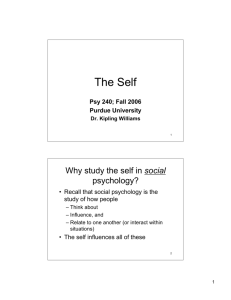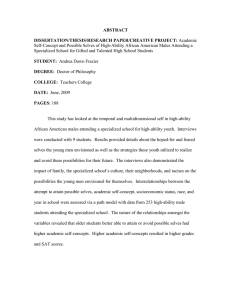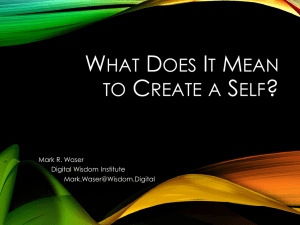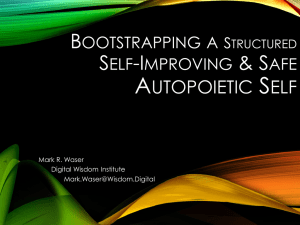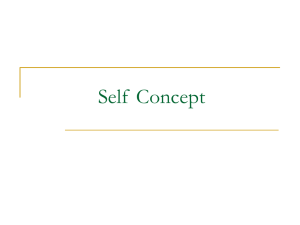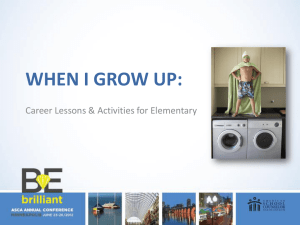What are the Implications of Possible Selves Research for School... Practice?
advertisement
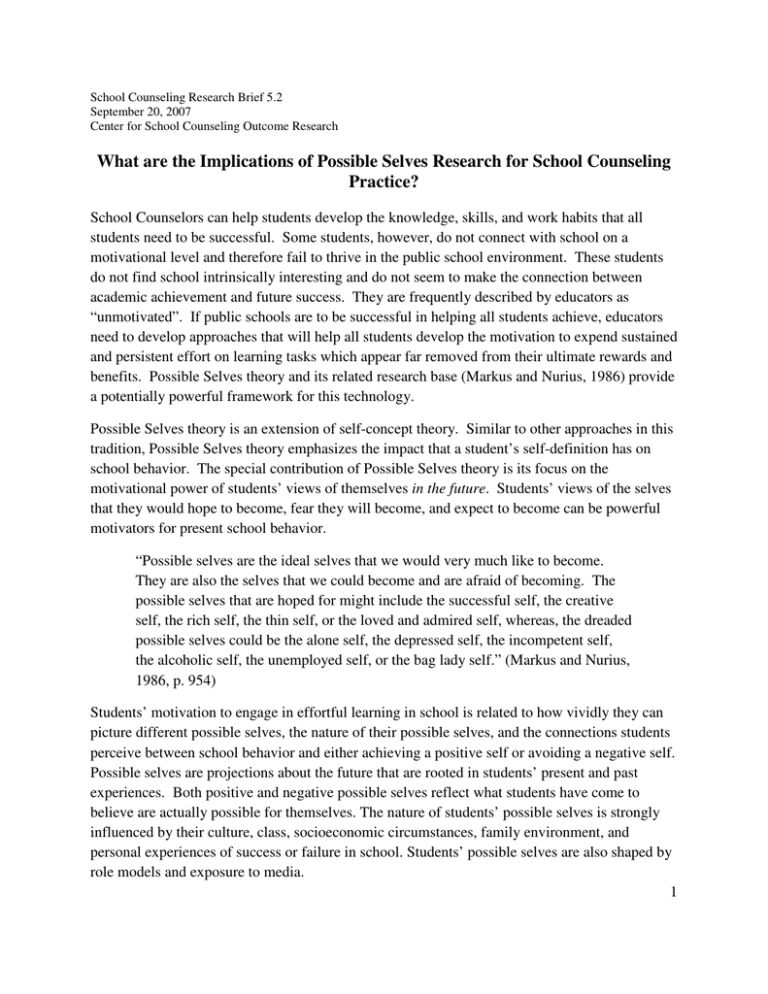
School Counseling Research Brief 5.2 September 20, 2007 Center for School Counseling Outcome Research What are the Implications of Possible Selves Research for School Counseling Practice? School Counselors can help students develop the knowledge, skills, and work habits that all students need to be successful. Some students, however, do not connect with school on a motivational level and therefore fail to thrive in the public school environment. These students do not find school intrinsically interesting and do not seem to make the connection between academic achievement and future success. They are frequently described by educators as “unmotivated”. If public schools are to be successful in helping all students achieve, educators need to develop approaches that will help all students develop the motivation to expend sustained and persistent effort on learning tasks which appear far removed from their ultimate rewards and benefits. Possible Selves theory and its related research base (Markus and Nurius, 1986) provide a potentially powerful framework for this technology. Possible Selves theory is an extension of self-concept theory. Similar to other approaches in this tradition, Possible Selves theory emphasizes the impact that a student’s self-definition has on school behavior. The special contribution of Possible Selves theory is its focus on the motivational power of students’ views of themselves in the future. Students’ views of the selves that they would hope to become, fear they will become, and expect to become can be powerful motivators for present school behavior. “Possible selves are the ideal selves that we would very much like to become. They are also the selves that we could become and are afraid of becoming. The possible selves that are hoped for might include the successful self, the creative self, the rich self, the thin self, or the loved and admired self, whereas, the dreaded possible selves could be the alone self, the depressed self, the incompetent self, the alcoholic self, the unemployed self, or the bag lady self.” (Markus and Nurius, 1986, p. 954) Students’ motivation to engage in effortful learning in school is related to how vividly they can picture different possible selves, the nature of their possible selves, and the connections students perceive between school behavior and either achieving a positive self or avoiding a negative self. Possible selves are projections about the future that are rooted in students’ present and past experiences. Both positive and negative possible selves reflect what students have come to believe are actually possible for themselves. The nature of students’ possible selves is strongly influenced by their culture, class, socioeconomic circumstances, family environment, and personal experiences of success or failure in school. Students’ possible selves are also shaped by role models and exposure to media. 1 Possible Selves and Academic Achievement Several studies document the relationships between students’ possible selves and their achievement and school-related behavior. Leondari, Syngollitou and Kiosseoglou (1998) studied the relationships between high school students’ possible selves and school behavior and performance. They coded students’ open-ended possible selves essays on a range of dimensions and correlated these different dimensions with both self-reported school behavior and achievement measures (i.e, GPA). Results indicated students who had clear and specific descriptions of their possible selves showed higher levels of task persistence and school achievement. Anderman, Anderman, and Griesinger (1999) reported two studies that illustrated relationships between elementary students’ possible selves and academic achievement. The authors found that students who had a positive academic future self (i.e. they described themselves as being a “good student”) were more likely to show academic improvement between the sixth and seventh grade. Oysterman and Markus (1990) explored the relationships between characteristics of the possible selves of 13- to 16-year-old students and their levels of delinquent behavior. The researchers constructed an open-ended questionnaire that probed for descriptions of hoped for, expected, and feared possible selves. The most salient finding was that non-delinquent youth showed a better balance between their expected and feared possible selves. Balance occurred when aspects of the expected self (e.g. graduating from college) would be expected to prevent the occurrence of the feared self (e.g., being poor and unemployed). When delinquent youth described their expected possible selves, they often failed to include features that mitigated against the possibility of their feared possible self occurring. For example, the feared possible self of delinquent students frequently entailed being unemployed; at the same time, few of these students described an expected possible self that included doing well in school. Similarly, Oyserman, Grant and Anger (1995) examined the relationship between the balance of positive and negative possible self descriptions for African-American middle school students and school performance. The research showed that a greater balance of positive and negative descriptions was predictive of effort and persistence in school. Taken as a whole, these studies suggest that (a) a vivid, concrete positive possible self that includes academic success can motivate present school behavior and result in achievement; and (b) while students may be motivated by both positive and negative features of their possible selves, the optimal motivational circumstance may occur when students’ expected possible selves include desired features (e.g. school achievement) that mitigate against the occurrence of the feared possible self features (e.g. criminality and unemployment). 2 Intervention Outcome Research on Possible Selves Interventions To date, there have been only a few attempts to develop and evaluate school counseling interventions based on Possible Selves theory and research. Two such attempts, described below, showed the potential of Possible Selves-based interventions to promote effective school behavior and reduce the academic achievement gap. Day, Borkowsky, Ponzo, and Howsepian (1994) developed and evaluated an eight lesson, small group-based intervention designed to increase the concreteness and balance of the positive and negative possible academic self descriptions of Mexican-American elementary school students. This intervention taught three specific metacognitive strategies that the researchers hypothesized could be used by students to attain a positive or avoid a negative possible self. These strategies included thinking ahead about the school work that needs to be done, thinking about the process of actually doing the school work, and thinking about what they have learned. An accompanying parent intervention was also designed and evaluated. Results of the child-only intervention group compared to the child-plus-parent intervention group proved showed no statistical difference, suggesting that the parent intervention did not add impact to the child intervention. Both of the intervention groups, however, showed important differences from the non-treatment control group. Children participating in the intervention groups showed increases in their understanding of the importance of education and their understanding of the relationship between education and later occupational success and financial security. They also showed more complete descriptions of the behavior of good students and reported thinking more about the connections between present schooling and future occupational success. Anecdotal findings indicated that three components of the intervention seemed particularly impactful: (a) creating a “Possible Me Tree” to provide a developmentally-appropriate framework for 3rd, 4th, and 5th graders to generate concrete visual maps of the distal goals; (b) using metacognitive strategies to achieve proximal academic goals; (c) explicit linking of current school work with distal educational and occupational status. Oyserman, Bybee and Terry (2006) developed and evaluated an 11-week, middle school, classroom-based intervention called School-to-Jobs (STJ). STJ was specifically designed to address hypothesized connections between aspects of urban African-American students’ possible selves and their school behavior and academic performance. The intervention was designed to help students: (a) develop description of their positive selves; (b) identify concrete, plausible strategies for attaining positive and avoiding negative possible selves; (c) reduce potential conflict between their possible selves and their social identity; and (d) maintain persistence in strategy use through metacognitive routines that designed to help students to avoid the tendency to abandon strategy use in the face of setbacks or failures. STJ was delivered in consecutive biweekly sessions in eighth grade homerooms with half the students in each homeroom randomly assigned to the intervention and non-treatment control groups. 3 Following the intervention, students had more balance between positive and negative selves and more plausible strategies for attaining positive and avoiding negative possible selves. Data indicated that the intervention resulted in increased attendance rates, reduced retention rates, higher GPA, and higher standardized test scores. Longitudinal data suggested the positive academic effects of STJ persisted at least through ninth grade and students who participated in the intervention had lower depression scores than non-participants. Implications, Development and Evaluation of New School Counseling Interventions These promising findings suggest that Possible Selves theory and research may provide a very useful foundation for preventative-developmental school counseling interventions that enhance students’ motivation, promote achievement and reduce the achievement gap. Efforts should be directed at using the existing knowledge base of Possible Selves theory to develop manualized, curriculum-based and group-based developmental school counseling interventions. Welldesigned school counseling interventions based on Possible Selves research are likely to promote academic achievement. Existing theory and research suggest that school counselors keep the following principles in mind when developing effective Possible Selves-based interventions: • • • • • Interventions that help students develop vivid, compelling visions of their “hoped for”, “feared”, and “expected” possible selves can be expected to promote achievement by enhancing students’ motivation. Students are more likely to translate enhanced motivation into actual achievement if the intervention is designed to help them: (a) see the connection between their current behavior and the attainment of desired future selves and/or the avoidance of undesired future selves; (b) establish goals that regulate and direct needed learning; and (c) identify specific skills and/or strategies that they have or need to learn to achieve their goals. Many students will benefit from interventions that expand their range of “hoped for” possible selves, especially when factors such as poverty, discrimination, media, and the absence of role models have resulted in an artificial constriction of possible futures . Interventions that help students envision a positive academic self that is strongly connected to attaining a desirable, or avoiding an undesirable future self, are more likely to promote achievement motivation and enhance school performance. Many students could benefit from interventions that integrate an achievement-oriented academic identity with a positive social group identity and harmonize those identities with achievement oriented goals. The school counseling profession needs more research-based and empirically-supported interventions focused on promoting academic achievement (Dimmitt, Carey, McGannon & Henningston, 2005). Using Possible Selves theory and research as the foundation for the design 4 and development of these interventions is clearly warranted. We strongly recommend that school counseling research and practitioners partner to create and evaluate preventativedevelopmental interventions. References Anderman, E.M., Anderman. L.H., & Griesinger, T. (1999). The relationship of present and possible academic selves during early adolescence to grade point average and achievement goals. The Elementary School Journal, 100, 3-17. Day, J.D., Borkowski, J.G., Punzo, D., & Howsepian, D. (1994). Enhancing possible selves in Mexican American children. Motivation and Emotion, 18, 79-103. Dimmitt, C., Carey, J.C., McGannon, W., & Henningson, I. (2005). Identifying a school counseling research agenda: A Delphi study. Counselor Education and Supervision, 44, 214-228. Leondari, A., Syngollitou, E., & Kiosseoglou, G. (1998). Academic achievement, motivation and possible selves. Journal of Adolescence, 21, 219–222 Markus, H., & Nurius, P. (1986). Possible selves. American Psychologist, 41, 954-969. Oyserman, D., Bybee, D., & Terry, K. (2006). Possible selves and academic outcomes: How and when possible selves impel action. Journal of Personality and Social Psychology, 91, 188–204 Oyserman, D., Gant, L. and Ager, J. (1995). A socially contextualized model of African-American identity: Possible selves and school persistence. Journal of Personality and Social Psychology, 69, 1216-1232. Oyserman, D., and Markus, H. R. (1990). Possible selves and delinquency. Journal of Personality and Social Psychology, 59, 112-125. John C. Carey Director, Center for School Counseling Outcome Research Ian Martin Graduate Assistant Center for School Counseling Outcome Research The Center for School Counseling Outcome Research is dedicated to enhancing school counseling by grounding practice in research. The Center publishes periodic Research Briefs that review research that is especially relevant to improving practice. The complete collection of briefs is available on the Center’s website, http://www.cscor.org. 5
